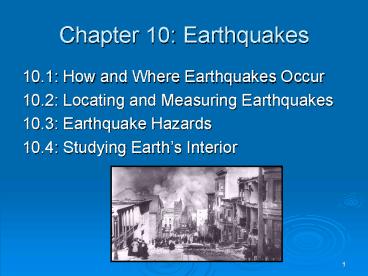Chapter 10: Earthquakes - PowerPoint PPT Presentation
1 / 19
Title:
Chapter 10: Earthquakes
Description:
Seismograph. 1. Detects and records waves produced by earthquakes. 2. ... Build Your Own Seismograph. 12. 10.3: Earthquake Hazards. Damage from Earthquakes ... – PowerPoint PPT presentation
Number of Views:62
Avg rating:3.0/5.0
Title: Chapter 10: Earthquakes
1
Chapter 10 Earthquakes
- 10.1 How and Where Earthquakes Occur
- 10.2 Locating and Measuring Earthquakes
- 10.3 Earthquake Hazards
- 10.4 Studying Earths Interior
2
10.1 How and Where Earthquakes Occur
- Causes of Earthquakes
- 1. Earthquake-The shaking of Earth's crust
caused by a release of energy. - 2. The cause of most major earthquakes is strain
that builds up along faults.
3
10.1 How and Where Earthquakes Occur
- 3. Fault-A break in the lithosphere along which
plate movement occurs. - 4. Focus-The point at which first movement
occurs during an earthquake. - 5. Epicenter-The point on the earth's surface
directly above the focus.
4
10.1 How and Where Earthquakes Occur
- Body Waves
- 1. The energy from an earthquake is released
in the form of waves. - 2. Body Waves- Waves that travel from the
focus to through the body of the earth.
5
10.1 How and Where Earthquakes Occur
- 3. P waves-Compression waves that squeeze and
stretch rock material. They can travel through
any material (water, magma, rock and air). - 4. S waves- Shear waves that cause material to
move at right angles to the direction of wave
travel. They can travel through solids but not
liquids or gases.
6
10.1 How and Where Earthquakes Occur
- C. Surface Waves
- 1. Earthquake waves that travel on the surface.
- 2. Appear when P and S waves reach the surface.
- 3. Cause the most damage. Why?
- 4. Two Types Love and Rayleigh. Love waves
move side to side. Rayleigh move in elliptical
patterns.
Because they are on the surface
- Animations of earthquake waves
- Examine P and S waves
- Savage Earth Restless Planet
7
10.2 Locating Measuring Earthquakes
- Seismograph
- 1. Detects and records waves produced by
earthquakes. - 2. Seismogram-A record sheet placed on a drum.
The drum turns slowly and any movement is
recorded on the paper. See page 217.
8
10.2 Locating Measuring Earthquakes
- B. Interpreting a Seismogram
- 1. P waves arrive first, then S waves.
- 2. The farther the station is from the
earthquake, the larger the separation between P
S waves lines. Why?
More time to get ahead. It is like a race
between two people at different speeds.
9
10.2 Locating Measuring Earthquakes
- C. Locating the Epicenter
- We can triangulate the epicenter by using three
different seismic stations. See page 219.
10
10.2 Locating Measuring Earthquakes
- D. Measuring an Earthquakes Magnitude
- Magnitude-A measure of the amount of energy
released in an earthquake. - The Richter Scale was developed in 1935. It
measures the amount of energy released by an
earthquake.
11
10.2 Locating Measuring Earthquakes
- 3. An increase of one whole number is equal to a
31-fold increase in energy. Ex. Mag. 6
earthquake is 31 times more powerful than a Mag.
5 earthquake. - Build Your Own Seismograph
12
10.3 Earthquake Hazards
- Damage from Earthquakes
- Damage is not only caused by the shaking from the
earthquake, but also by foundation failure, fire
and tsunamis. - Liquefaction-Occurs when loose soil temporarily
takes on some of the properties of a liquid.
This causes buildings and roads to collapse.
13
10.3 Earthquake Hazards
- 3. Aftershocks-Series of small earthquakes that
follow the initial quake. - 4. Fire can cause substantial damage. It is
usually triggered by ruptured gas lines. - 5. Tsunamis-A huge ocean wave triggered by an
earthquake. Can travel long distances at speeds
up to 750 kph.
14
10.3 Earthquake Hazards
- Preventing Earthquake Damage
- Earthquake prone cities have special building
codes to help prevent building collapse. - Monitoring equipment helps to continue learning
what structures hold up the best during an
earthquake.
15
10.3 Earthquake Hazards
- C. Earthquake Risk
- Areas near plate boundaries are not the only
areas at risk. - New Madrid, MO is located near several faults
buried under large amounts of sediments.
16
10.3 Earthquake Hazards
- D. Predicting Earthquakes
- Seismic Gaps- Areas where stress may be building
up along a fault. - Scientists can predict at risk areas, but not
specific locations or times.
17
10.4 Studying Earths Interior
- The Shadow Zone
- Changes in the speed and direction of P and S
waves indicate changes in the composition and
state of the earth's interior. - A shadow zone is created by these changes.
Remember that S waves cannot travel through
liquids. See page 228.
18
10.4 Studying Earths Interior
- B. The Moho
- Boundary between the crust and the mantle.
- Where the dense rock of the mantle meets the less
dense rock of the crust. - Located about 32 km under continents and 5-10 km
under the oceans. Why?
The crust is thinner in the ocean.
19
10.4 Studying Earths Interior
- Transition Zone
- Region in the middle of the mantle where the
densities of the upper and lower mantle vary. - This change is due to changes in pressure as
depth increases.

